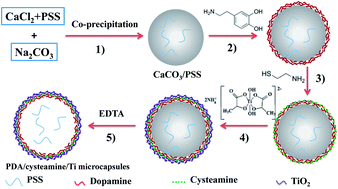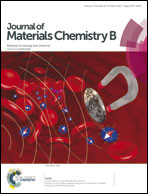Conferring an adhesion layer with mineralization-inducing capabilities for preparing organic–inorganic hybrid microcapsules†
Abstract
In this study, a novel approach to prepare organic–inorganic hybrid microcapsules was developed by conferring an adhesion layer with mineralization-inducing capabilities under mild conditions. The wall of hybrid microcapsules consisted of two layers: an organic layer (adhesion layer) and an inorganic layer (biomineral layer). The organic layer was formed through rapid oxidative self-polymerization of dopamine into polydopamine (PDA) on a CaCO3 (PSS-doped) template surface. Then cysteamine was grafted onto the adhesion layer to induce the formation of titania, thus, constructing the biomineral layer. Notably, cysteamine acted as a bridge between the two layers to enhance the interfacial stability: (1) the –SH groups of cysteamine can react with the catechol groups of PDA to form covalent bonds through Michael addition or Schiff base reaction; (2) the –NH2 groups of cysteamine can induce the formation of titania. The hybrid microcapsules (PDA/cysteamine/Ti microcapsules) acquired much higher mechanical stability than pure PDA microcapsules. At 20% (w/v) PSS solution, 65% of PDA microcapsules were deformed, whereas, at 40% (w/v) PSS solution, only ∼6% of PDA/cysteamine/Ti microcapsules were deformed. Finally, catalase (CAT) was physically encapsulated in the microcapsule lumen. The immobilized CAT exhibited good recycling stability and high storage stability. Besides biocatalysis, the hybrid microcapsules may find applications in biomedical and biosensing fields.


 Please wait while we load your content...
Please wait while we load your content...